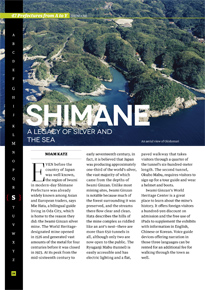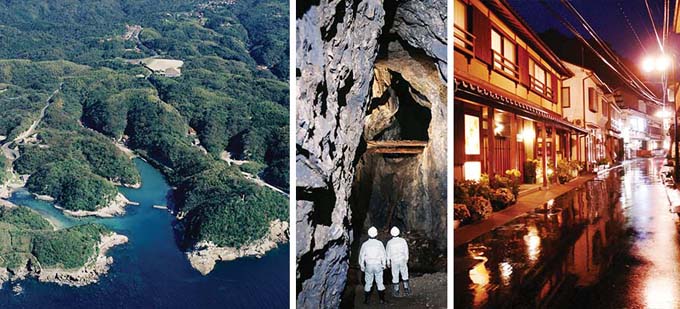Home > Highlighting JAPAN >Highlighting Japan November 2014> 47 Prefectures from A to Y
Highlighting JAPAN

47 Prefectures from A to Y
Shimane
A Legacy of Silver and the Sea

Even before the country of Japan was well known, the region of Iwami in modern-day Shimane Prefecture was already widely known among Asian and European traders, says Mie Hata, a bilingual guide living in Oda City, which is home to the reason they did: the Iwami Ginzan silver mine. The World Heritage-designated mine opened in 1526 and generated vast amounts of the metal for four centuries before it was closed in 1923. At its peak from the mid-sixteenth century to early seventeenth century, in fact, it is believed that Japan was producing approximately one-third of the world’s silver, the vast majority of which came from the depths of Iwami Ginzan. Unlike most mining sites, Iwami Ginzan is notable because much of the forest surrounding it was preserved, and the streams there flow clear and clean. Hata describes the hills of the mine complex as riddled like an ant’s nest—there are more than 650 tunnels in all, although only two are now open to the public. The Ryuganji Mabu (tunnel) is easily accessible and has electric lighting and a flat, paved walkway that takes visitors through a quarter of the tunnel’s six-hundred-meter length. The second tunnel, Okubo Mabu, requires visitors to sign up for a tour guide and wear a helmet and boots.
Iwami Ginzan’s World Heritage Center is a great place to learn about the mine’s history. It offers foreign visitors a hundred-yen discount on admission and the free use of iPads to supplement the exhibits with information in English, Chinese or Korean. Voice guide devices offering narration in those three languages can be rented for an additional fee for walking through the town as well.
In the sixteenth century, silver bound for Korea and China was brought to either Okidomari or Tomogaura, two nearby ports on the Sea of Japan. You can still see the protruding rock formations there known as hanaguri-iwa that were used to moor the boats at both ports.
The ports brought prosperity to Yunotsu, the hot spring town to become part of a World Heritage site. Yunotsu significantly predates Iwami Ginzan with a 1,300-year history, and its hot springs are reported to have therapeutic effects on rheumatism and allergies. A stroll on the main road through the town takes you past scenic old buildings and traditional Japanese inns.
Oda City also has a more modern attraction. In Nima Sand Museum, the world’s largest sand hourglass counts down an entire year. This museum offers a range of exhibits that include about a hundred different sizes of hourglasses and two hundred samples of Japan’s sand, as well as a hundred samples of sands from other countries.
It’s an excellent idea to combine a visit to the mine with a stroll around the town of Omori, once the heart of the mining complex and home to magistrates, merchants and artisans working in connection with the mine.
Even now around four hundred people inhabit this quaint community of homes, shops and cafés. The Kumagai family residence—a stately, well-preserved dwelling dating back to 1801—is one worth seeing. Designated an Important Cultural Property of Japan, the residence houses many original artifacts from the Edo Period through the Meiji Period.
Wakako Tanabe from the prefectural government’s Tourism Promotion Division recommends allowing a little time to appreciate all there is to see in Shimane. “Of course we know foreign tourists will first want to visit places like Tokyo and Kyoto,” she says, “but if you want to know more about traditional Japan, I’d like them to include Shimane in their travel plans.”
© 2009 Cabinet Office, Government of Japan






